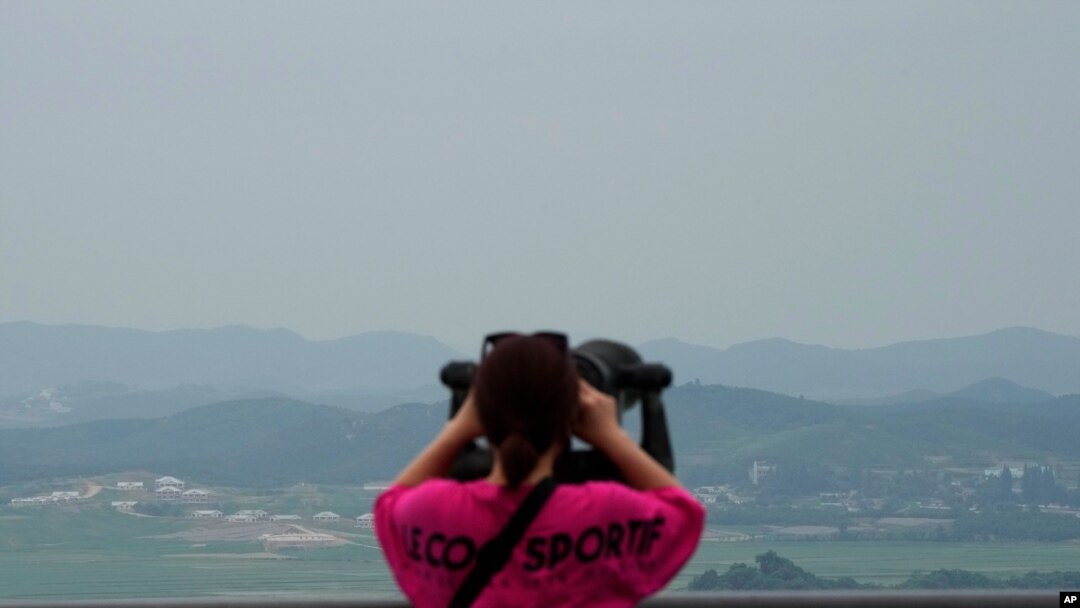North Korean leader Kim Jong Un has exchanged several letters since April with his South Korean counterpart Moon Jae-in, Seoul announced Tuesday, in a possible sign Pyongyang is ready to resume engagement with the outside world.
As part of the exchange, the two men agreed to restore an inter-Korean hotline at the border village of Panmunjom, with a first phone call occurring at 10 a.m. Tuesday local time, South Korea’s presidential office said in a statement.
Separately, South Korean officials said that two other cross-border communication lines have been restored, including a military channel and one that used to be associated with an inter-Korean liaison office, which the North demolished last year.
The North’s official Korean Central News Agency confirmed the hotline restoration and letter exchange, calling the moves a “big stride in recovering the mutual trust and promoting reconciliation” between the two Koreas.
“Now, the whole Korean nation desires to see the north-south relations recovered from setback and stagnation as early as possible,” the KCNA report said.
The dialogue appears to be the most significant North-South interaction in about two years. Analysts will now be waiting to see whether the North also resumes discussions with the United States or accepts international offers of pandemic help.
Precursor?
Inter-Korean dialogue has preceded wider talks before.
Moon and Kim met three times in 2018, paving the way for the summits between the North Korean leader and former U.S. President Donald Trump.
But after the U.S.-North Korea talks broke down in 2019, the North turned against Seoul. Last year, North Korea cut several inter-Korean communications lines and demolished a joint liaison center near the border.
South Korea’s left-leaning administration, which has less than a year left in office, has consistently pushed for a resumption of talks, even while often receiving scornful statements in return from Pyongyang.
Seoul said Tuesday it hopes the hotline restoration will be the first step in a wider improvement of ties. Moon and Kim “agreed to restore mutual trust and re-progress the relationship as soon as possible between the two Koreas,” the statement from Seoul’s presidential office read.
Earlier this month, South Korea’s Joongang Ilbo reported the existence of the Moon-Kim letter exchange, saying the two men were discussing a fourth, virtual summit. South Korean officials have not commented on the possibility of another meeting.
Pyongyang had been quiet
Since last year, North Korea has mostly focused on domestic issues, including the coronavirus.
North Korea insists it has detected no COVID-19 cases, though few observers believe that. An outbreak in the North could be devastating, since the country has an uneven health infrastructure and limited medical supplies.
So far, North Korea has rejected offers of pandemic help from South Korea and the United States.
But last month, Pyongyang hinted it may be open to talks, with Kim saying Pyongyang should be ready for both dialogue and confrontation with Washington.
The administration of U.S. President Joe Biden says it is prepared to enter a “calibrated, practical approach” to diplomacy with North Korea. It has also said it supports improved inter-Korean relations.
Potential hurdles
But improved ties will face several challenges, including U.S.-South Korea military exercises scheduled for next month.
South Korean army K-9 self-propelled howitzers park in Paju, near the border with North Korea, South Korea, March 24, 2021.
North Korea usually reacts angrily to the joint drills and often uses the occasions to test-fire weapons or make other provocative statements.
Since the Trump-Kim diplomacy began in 2018, the U.S. and South Korea have scaled back major military exercises, in an attempt to preserve diplomacy.
Another challenge is South Korea’s political calendar. President Moon’s single, five-year term ends in less than a year.
Though it is early, opinion polls suggest Moon’s ruling Democratic Party will be locked in a tight race with the main conservative People Power Party in the March 2022 presidential election. Conservative South Koreans generally take a more combative approach toward Pyongyang.
However, polls suggest inter-Korean talks are widely popular in South Korea. If the talks progress, the ruling Democratic Party will have a better chance to keep the presidency, says Lee Sang-sin, a political science expert who focuses on public opinion at the Korean Institute for National Unification.
“Any time the two Koreas talk, the presidential approval ratings skyrocket,” Lee told VOA.
Lee says Moon has plenty of time for talks, noting that there were only two months left in his term when former South Korean President Roh Moo-hyun met his North Korean counterpart Kim Jong Il in 2007.
Perhaps the biggest obstacle to inter-Korean cooperation are international sanctions meant to punish North Korea for its nuclear and missile programs.
A wide range of economic and other interactions with North Korea is prohibited under several sets of sanctions imposed by the United States and United Nations.
Though South Korea’s Moon has repeatedly said he wants to advance inter-Korean initiatives, he has given few signs he will explicitly violate sanctions in order to do so.
As a result, if North-South relations are to drastically improve, so must U.S.-North Korea ties.
But that has been a challenge since 2019, when Trump walked away from his second summit with Kim in Vietnam.
“That’s why we have to go back to Hanoi,” Lee said.


